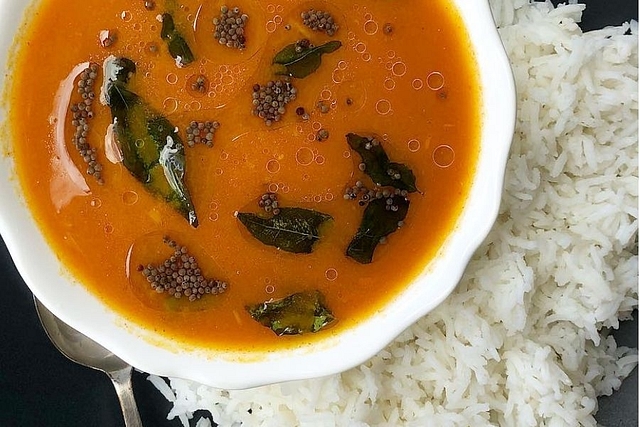
Human Immunity And Rasam: What We Know And Don’t
Tradition has it that a Brahmin priest came up with this formulation to cure a Pandya prince who was suffering from an ailment that could not be cured with any then known medicines.
Note: This piece does not say that consuming rasam will prevent a person from contracting Covid-19. It talks about how rasam boosts immunity.
In 2015, the Nobel Prize for medicine was shared by three people, of whom Youyou Tu attracted high attention.
Neither a ‘doctor’ and nor an academic PhD, her research was in traditional Chinese medicine (TCM).
In the early 1970s, she isolated an anti-malarial principle artemisinin from a well-known Chinese herb, sweet wormwood, or Artemisia annua.
Now, in 2020, there is a chance that a culinary delight from traditional Hindu culture can play a role in effecting a food-based resistance to the spread of COVID-19 mortality rate by boosting the resistance of the body.
Given the fact that the presence of background diseases along with the age-factor increases the chances of COVID-19 fatality, a boost in immunity is important in battling the viral epidemic.
In this, rasam seems to have triggered some renewed interest of late.
‘Rasam’ is a southern Indian common liquid food item consumed by people from all sections of the society.
Tradition has it that a Brahmin priest came up with this formulation to cure a Pandya prince who was suffering from an ailment that could not be cured with any then known medicines.
Rasam in Sanskrit means ‘essence’.
In Vedic literature, rasa is the living fluid essence - from the breast milk through clarified butter to the juice of the fruits - rasa is the very essence of life.
In the culinary context then, rasam becomes a very important component in Indian meals.
What we know
A study in 2014 discussing the medicinal values of various southern Indian traditional food items has pointed out that like all things Indic, rasam also comes in quite a number of varied forms, each with their own medicinal valuer
<i>Selavu rasam</i> a known traditional food of Tamilnadu is prepared by boiling and seasoning a mixture of ground ingredients of black pepper, coriander seed, jeeragam, garlic and curry leaves. <i>Selavu rasam</i> is not only given to children and adult with cough, but also to lactating mother after their child birth. Vitamin C was rich in recipes like <i>Murugai keeerai rasam</i> (8.96mg) and <i>Millagu rasam</i> (10.55mg). Karthika Devi & Premala Priyadharshini, <i>Exploration of Nutrient Content of Traditional Receipes of Tamil Nadu with Therapeutic Properties</i>, I<i>mpact Journa</i>l, Vol.2, Iss.10, Oct 2014
Traditional medical systems also fortify the rasam against microbial diseases with local herbal ingredients.
Studies by researchers from the department of biotechnology, SRM University and National Institute of Siddha, Chennai, reveal that 'Thaaleesaadhi chooranam', a polyherbal formulation prepared from 23 different herbs is mixed with rasam and given to people to build in them resistance against microbial infections.
Professor Agilandeswari Devarajan of the Department of Pharmaceutics, Hillside College of Pharmacy and Research Centre, Bengaluru, has been studying this delicacy for quite some time along with researcher Mohan Maruga Raja of PRIST University, Thanjavur.
Defining rasam as a traditional preparation with 'tamarind juice as a base, with the addition of Indian sesame oil, turmeric, tomato, chili pepper, pepper, garlic, cumin, curry leaves, mustard, coriander, asafoetida, sea salt, and water' they state that 'preclinical and clinical studies on rasam and its ingredients support' the traditional claims of medicinal values of rasam.
What we don’t
They point out that 'the real challenge lies not in proving whether the functional foods have health benefits' but 'in investigating the bioactive properties of these functional foods beyond a nutritional context'.
The study after describing the various common individual components of the rasam then points to an important fact - the processing factor
The processing in the formulation of rasam involves heating the spices in water and oil. This processing provides tremendous opportunity for a completely altered/different chemical composition of the finally formulated rasam. Loss of active principles or synergetic effect or breakdown of inactive metabolite to an active one or formation of new chemical entities (NCEs) is a real possibility.Devarajan A, Mohanmarugaraja MK. <i>A Comprehensive Review on Rasam: A South Indian Traditional Functional Food</i>, <i>Pharmacognosy Reviews</i>. 2017 Jul-Dec;11(22):73-82
This study published in the peer-reviewed journal 'Pharmacognosy Reviews' in 2017 says that a study of rasam with respect to these newly formed chemicals would reveal the following:
-the structural and functional features of these newly formed chemicals in the context of body's physiology and biochemistry;
-the same in the context of the origin and development of diseases;
-how these new entities emerging out of rasam interact with them;
-and interaction between organic and inorganic constituents.
Now with COVID-19 spread necessitating the building of measures to increase the disease resistance of the general population, India does have a great advantage of using her traditional food system, fortified by local medical knowledge to achieve this goal in a cost-effective and efficient way.
Rasam - a very easy to make food item makes itself available to all sections of the society.
And who knows an active principle that may inhibit COVID-19 may be hiding in plain sight in one of the rasam recipes of a village grandmother, waiting for our labs to find out.